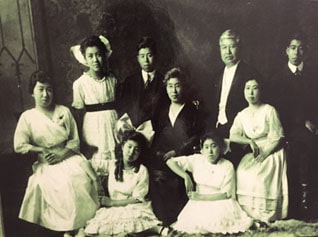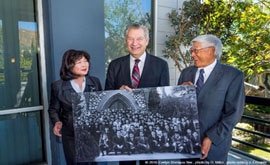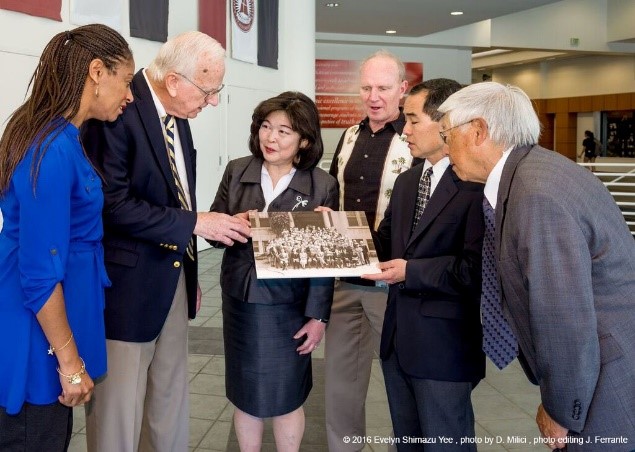by Evelyn Shimazu Yee, Associate Professor, Library Faculty, Curator
Members of the library community and local Japanese American communities from Los Angeles, the San Gabriel Valley, Orange and San Diego Counties, as well as those from Northern California, Hawaii, Oregon, Washington, Arizona, the Midwest, and the East Coast visited a rare exhibit at APU. This exciting, one-of-a-kind American archive brings a new set of stories to what was previously considered Californian and American history. It tells a story about significant successful intercultural collaborative American/California/Asian ethnic mission building during the Victorian and Edwardian eras. A growing collection of over 400 items representing stories from several dozen individuals and families confirm this intriguing history.
Beginning in the mid to late 1800s a groups of Mejii era Nikkei (multi-generation Japanese American) aristocrats, intellectuals, missionaries and former samurai families from Japan allowed their adventurous young people to travel to American and English institutions of higher learning such as Princeton and Oxford. Some became the founding pastors of Nikkei ethnic missions. Being educated in Asia and in Western Universities allowed them to better navigate the language and myriad of American laws and customs on behalf of the missions. Nikkei and white missionaries worked together, much like a family business. Led by Princeton graduate Rev. Joseph K. Inazawa and others like him, they built over 36 California missions at the turn of the last century.

Unable to own land and purposely given only leases to swampland, Issei (first generation Japanese immigrants) used draining and hard work to become greatly successful in farming where no others would farm. They were generous donors to further the work of the missions. Mission leaders, both Nikkei and white, taught language, culture, and ethics classes for businessmen, mothers, and their children.. They shared meals and burdens. When white missionaries had health setbacks, the Issei lovingly cared for them as did the white missionaries for the Nikkei. The Nikkei community was very grateful and reciprocal. This was model cooperation between people of different races but of a common faith family that knew no racial boundaries. Historical items were preserved over 120 years despite the circumstances of the three year exile into concentration camps. Missionary friends stored some items for some incarcerated.

Azusa Pacific University (APU) began as a missionary training grounds. The school educated major founding leaders in the Nikkei community. Unlike the Spanish Missions, the historical Nikkei American Missions abandoned the colonization model. Nikkei missions were successful and sustainable, we believe, because of the fact that missionaroes uniquely viewed the differences in race as superseded by a deeply shared common cultural belief by both groups of Imago Dei, principles of equity across the spectrum of humankind. They respected one another as individuals. There was a mutual respect for cultures in deep intercultural exchange. The Nikkei were autonomous as partners and leaders in their missions. There was an unusual spirit of brotherhood and sisterhood at a time when diverse races were not readily welcomed and ethnic exclusionary laws toward Asians (namely Chinese and Japanese) were at an all-time high regardless of their model behavior. Hateful graffiti, arson, shootings, and second class treatment in public venues was common place. Following discriminatory laws against the Chinese, Japanese long time legal residents were then also barred from naturalized citizenship, barred from owning property, and in many cases Chinese and Japanese children were forced to attend segregated schools.
In the header photo, appearing left to right: Kim B.W. Denu, Ph.D., Former APU Vice President, Chief Diversity Officer; Thomas Andrews, Ph.D., Historian; Evelyn Shimazu Yee, M.L.I.S. Associate Professor, University Libraries, and Curator of the Historical Missions of Nikkei Heritage Archive; Donald Isaak, Ph.D., Director of the Office of Research and Grants, Alan Oda, Ph.D., Professor, Psychology; and Rev. Dr. Samuel Tonomura, Former Executive Director of JEMS examine a historical photo.

